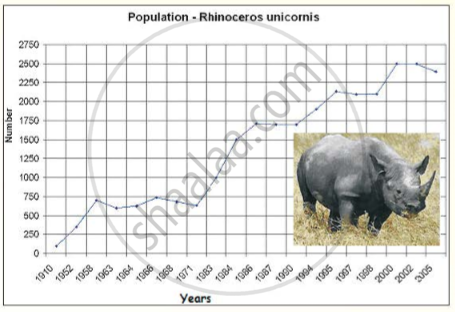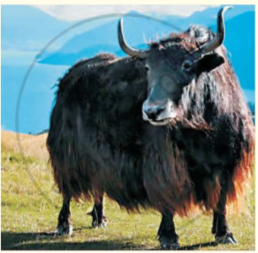Advertisements
Advertisements
प्रश्न
Read this article about the great Indian Rhinoceros. [You will find the information useful for your group discussion in 5.]
The Indian Rhinoceros or the Great One-Horned Rhinoceros or the Asian Onehorned Rhinoceros (Rhinoceros unicomis) is a large mammal primarily found in north-eastern India, Nepal and parts of Bhutan. It is confined to the tall grasslands and forests in the foothills of the Himalayas.
The Indian Rhinoceros once ranged throughout the entire stretch of the Indo Gangetic Plain but excessive hunting reduced their natural habitat drastically.
Today, about 3,000 Indian Rhinos live in the wild, 1,800 of which are found in Assam alone. In 2008, more than 400 Indian Rhinos were sighted in Nepal's Chitwan National Park.
In size it is equal to that of the White Rhino in Africa; together they are the largest of all rhino species. The Great One-Horned Rhinoceros has a single horn; this is present in both males and females, but not on newborn young. In most adults, the horn reachee a length of about 25 centimetres, but has been recorded up to 57 .2 centimetres in length. The nasal hom curves backwards from the nose. The horn is naturally black.
This prehistoric-looking rhinoceros bas thick, silver-brown skin which becomes pinkish near the large skin folds that cover its body. The male develops thick neckfolds. It has very little body hair aside from eyelashes, ear-fringes and tail-brush.
These rhinos live in tall grasslands and riverine forests, but due to the loss of habitat, they have been forced towards cultivated land. They are mostly solitary creatures, with the exception of mothers and calves and breeding pairs, although they sometimes, congregate at bathing areas.

The Indian Rhinoceros makes a wide variety of vocalizations. At least ten distinct vocalizations have been identified: snorting, honking, bleating, roaring, squeak panting, moo-grunting, shrieking, groaning, rumbling and humphing. In addition to noises, the rhino also uses olfactory communication.
In aggregation, Indian Rhinos are often friendly. They will often greet each other by waving or bobbing their heads, mounting flanks, nuzzling noses, or licking. Rhinos will playfully spar, run around, and play with twigs in their mouth. Adult males are the primary instigators of fights. Fights between dominant males are the most common cause of rhino mortality. Indian rhinos have few natural enemies, except for tigers. Tigers sometimes kill unguarded calves, but adult rhinos are less vulnerable due to their size. Humans are the only other animal threat, hunting the rhinoceros primarily for sport or for the use of its horn. Indian Rhinos have been somewhat tamed and trained in circuses, but they remain dangerous and unpredictable animals.
In the nineteenth and early twentieth century, the Indian Rhinoceros was hunted relentlessly. Reports from the middle of the nineteenth century claim that some military officers in Assam individually shot more than 200 rhinos. In the early 1900s, officials became concerned at the rhinos' plummeting numbers. By 1908 in Kaziranga, one of the Rhinos' main ranges, the population had fallen to around 12 individuals. In 1910, all rhino hunting in India became prohibited.
The rhino has been a major success in conservation. Only 100 remained in the early 1900s; a century later, their population has increased to about 2500 again, but even so, the species is still endangered. The Indian rhino is illegally poached for its horn. Some cultures in East Asia believe that the hair has healing and potency powers and therefore is used for traditional Chinese medicine and other Oriental medicines.
The Indian and Nepalese Governments have taken major steps towards Indian Rhinoceros conservation with the help of the World Wildlife Fund (WWF). The Kaziranga National Park and Manas National Park in Assam, Pobitora Reserve Forest in Assam {having the highest Indian rhino density in the world), Orang National Park of Assam, Laokhowa Reserve Forest of Assam (having a very small population) and Royal Chitwan National Park in Nepal are homes to this endangered animal.
उत्तर
Summary of the extract :
The Indian Rhinoceros is mainly found in north eastern part of the Indian peninsula. During early 1900s the population of rhino dipped to as low as about 100. Rhino conservation in India is a success story with current population standing at about 3000. Rhinos are usually solitary animals but make group for reproduction. They are big animals and have virtually no enemy because of their size. They are poached for their horns which are supposed to have aphrodisiac properties. Kaziranga is one of the major sanctuaries for rhinos.

| DOMESTIC YAK |
| herd animals 2-2.2 m tall |
| used in sports |
| kept for milk , fur , fibre , meat , drawing ploughs etc |

| WILD YAK |
| length:3-3. 4m |
|
habitat: treeless uplands
|
| killed for food |
| insulated from cold by dense, close matted under hair , shaggy outer hair |
| hunted for similar reasons as the domestic ones |
APPEARS IN
संबंधित प्रश्न
Find the sentences in the lesson which have the adverbs given in the box below.
Awfully, sorrowfully, completely, loftily, carefully, differently, quickly, nonchalantly
Such wondrous, fine, fantastic tales
Of dragons, gypsies, queens, and whales
And treasure isles, and distant shores
Where smugglers rowed with muffled oars,
And pirates wearing purple pants,
And sailing ships and elephants,
And cannibals crouching 'round the pot,
Stirring away at something hot.
(It smells so good , what can it be?
Good gracious, it's Penelope.)
The younger ones had Beatrix Potter
With Mr.Tod,the dirty rotter,
And Squirrel Nutkin,Pigling Bland,
And Mrs.Tiggy-Winkle and-
Just How The Camel Got His Hump,
And How the Monkey Lost His Rump,
And Mr. Toad, and bless my soul,
There's Mr.Rat and Mr. Mole-
Oh, books, what books they used to know,
Those children living long ago!
Read the lines given above and answer the question given below.
Explain with reference to context.
This woman had been despised, scoffed at, and angrily denounced by nearly every man, woman, and child in the village; but now, as the fact of, her death was passed from lip to lip, in subdued tones, pity took the place of anger, and sorrow of denunciation.
Neighbours went hastily to the old tumble-down hut, in which she had secured little more than a place of shelter from summer heats and winter cold: some with grave-clothes for a decent interment of the body; and some with food for the half-starving children, three in number. Of these, John, the oldest, a boy of twelve, was a stout lad, able to earn his living with any farmer. Kate, between ten and eleven, was bright, active girl, out of whom something clever might be made, if in good hands; but poor little Maggie, the youngest, was hopelessly diseased. Two years before a fall from a window had injured her spine, and she had not been able to leave her bed since, except when lifted in the arms of her mother.
“What is to be done with the children?” That was the chief question now. The dead mother would go underground, and be forever beyond all care or concern of the villagers. But the children must not be left to starve.
Read the extract given below and answer the question that follow.
Why was the dead woman despised and hated by all the people of the village?
Who is Canynge? What scandal is being referred to? Why will it be a scandal?
On which planet do Tilloo and his parents live?
What is in general, the relationship between a mongoose and a snake?
How did the mongoose oblige its master? What was the reward of his service?
Read the following passage and do the exercises that follow. Then complete the family tree of dogs given on the facing page.
The Dog Family
The dog family is one of the 11 families that make up the Carnivores, a large group of intelligent, flesh-eating, backboned animals. In this group are such varied animals as bears, pandas, raccoons, cats, hyenas, and even seal. The dog or canine family has many wild species like wolves, foxes, coyotes, jackals, and wild dogs. The dog is the only domesticated member of the canine family though now and then someone tames a wolf, fox or coyote as a pet. All members of the dog family are descendants of a wolf-like animal which lived about 15 million years ago. From this distant ancestor, the true dogs gradually developed. But nobody knows the exact ancestor of the modern domestic dog.
Several wild dogs look and behave like domestic dogs. The dingo or wild dog of Australia is one of these. It is possible that the dingo was a tamed dog brought to Australia long ago which then ran wild. Dogs were the first animals tamed by humans — perhaps 20,000 years ago. Tamed dogs were brought from Asia to the New World 5,000 or more years ago. Dogs were first used for hunting.
Find the opposites of these words in the text above.
(i) ancestor _________
(ii) wild t _ m _
(iii) ancient _________
(iv) near d _______ t
(v) suddenly gr ___________
Complete the following sentences.
(i) The dingo is __________________________________________________.
(ii) Dogs were the ____________________________________________animals tamed by humans. The other animals tamed by humans are __________________________
_________________ (Think and name some other such animals.)
(iii) The New World refers to ___________________________.
Dogs were brought there from ________________________.
Family Tree of Dogs
Read the newspaper report to find the following facts about Columbia’s ill-fated voyage.
Number of astronauts on board: ____________
Referring closely to the short story, The Cookie Lady, explore Mrs. Drew’s fascination with Bubber. Answer in 100-150 words incorporating the following details.
- Mrs. Drew’s repeated interactions with Bubber
- Role of the cookies in the short story
